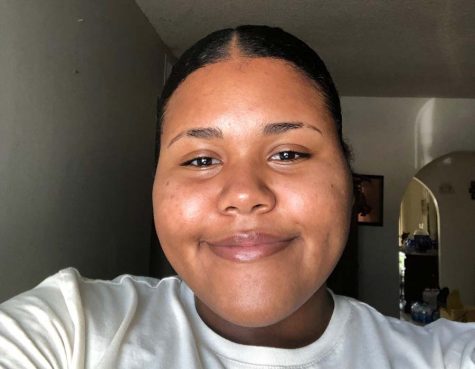Black Lives Matter movement engages students and teachers
COVID-19 isn’t the only tragedy impacting lives in recent months.
On February 23, 2020, Ahmaud Arbery, a 25-year-old unarmed African American man was murdered by three White men while jogging in Glynn County
On March 13, 2020, Breonna Taylor, a 26-year-old African American emergency medical technician was fatally shot by three Louisville Metro Police officers in her home.
On May 25, 2020, a 46-year-old Black American man was killed in Minneapolis, Minnesota during an arrest for allegedly using a counterfeit bill. The police officer, Derek Chauvin, had his knee on George Floyd’s throat for eight minutes as he repeatedly cried out “I can’t breathe.”
Floyd’s tragic death sparked protests in nearly every state in the United States. Unfortunately, many of these protests became riots, and buildings were burned down or looted. What didn’t always make the news was how many people were participating in peaceful protests and marches.
I was one of a group of BLM supporters who stood on the corner of Ridgecrest and China Lake Blvds. across from the Bank of America and protested every single night during the first week of June. On Saturday, June 6, we marched from Leroy Jackson Park to City Hall. These events had a broad range of participants, including Burroughs students, teachers and members of the community. One of the very first nights of protesting, Ridgecrest Police Department Officer Hallmark joined us.
To understand why we joined together, we want you to know what the Black Lives Matter movement is and what it stands for.
Black Lives Matter is a movement advocating for non-violent civil obedience in protest against police brutality and racially motivated violence against Black people.
When we say “Black Lives Matter,” we don’t mean only Black lives matter. What we do mean is that for decades Black people have fallen victim to police brutality cases and racially-motivated hate crimes. Despite being only 13% of the U.S. population, they have been 28% of those killed by police, according to the Mapping Police Violence website (retrieved August 24, 2020).
Why is this happening? Many Black people are seen in a negative way, according to statistics provided by the Pew Research Center, which found that more than 150 years after the 13th Amendment abolished slavery in the United States, most adults say the legacy of slavery continues to have an impact on the position of Black people in American society today.
Slavery should never be forgotten because it’s an important part of history that has obviously had an impact in our present-day society. But Black people are not slaves anymore. We aren’t all thugs and criminals. We are so much more, and the color of our skin shouldn’t determine how someone sees us.
The BLM movement isn’t only supported by people of color; it is also supported by some Whites. As a majority of the U.S. population, white people have a powerful voice. In my opinion, if as many White people supported the movement and advocated for it, they could have a major impact.
Burroughs graduate Kaycee Kohut, one of the co-hosts of the Ridgecrest BLM march, said she absolutely supports BLM.
“It’s not about superiority,” said Kohut. “It’s about dismantling the racist ideas and institutions that have existed since the formation of the US (and long before that). It’s about EQUALITY, whether anti-BLM people believe that or not. Black Lives Matter and that should not be controversial.”
George Floyd’s death sparked a series of protests, riots and petitioning across the country as people were outraged to see another Black person lose his life to police brutality.
Burroughs English Teachers Eileen Poole and Ernestina Palerm Wilson both attended the local march.
“Of course I went to the local march for equality, for Black Lives Matter,” said Poole. “It was inspiring. About 300 Ridgecrest folks joined together to promote a simple truth, a truth that has been ignored for too, too long. I’ve participated in many local marches, and this one was the largest and most diverse. I felt hopeful. Maybe this time it will take hold. Maybe from the ugliness and horror that plague 2020 goodness will emerge, goodness manifested in equality and justice. Black Lives Matter.”
Burroughs senior Alivia Eubank thinks that the recent marches have had an impact in elevating the issue across the country.
“I think the protests throughout the U.S. have shown the government that we will not quit,” said Eubank. “The protests are ongoing and we will not give up until there is a reform.”
Reform has long been sought. In 1964, a Civil Rights Act was signed into law, banning discrimination based on race, color, religion, sex, or national origin, but segregation was still normalized. Sit-in protests were used is discriminatory establishments to fight against segregation, but segregationists were outraged and attacked Black demonstrations. It took years of protesting and marching for laws to be passed by the government. Now we are using the same method in hopes of achieving necessary change.
Palerm Wilson thinks the movement today has a crucial difference that might help it close in on its goals.
“I had this conversation with my father. He said that in 1963 and later, the crowds were mostly Black. There were few others represented in the crowds. Today, the protests are being attended by millions, and those millions are Black, White, Latinx, Native American, Asian, male, female, transgender,” she said. “More people, more impact.”
The people who support BLM understand that if more groups band together, we can really have an impact on how we’ll be treated.
Black Lives Matter was never about black people only supporting black people. It’s about all ethnic groups supporting other ethnic groups until we are all united. No lives matter until Black Lives Matter. Black Lives Matter today, tomorrow, and forever.

This is Delaena's first year in Newswriting. She is an AVID student and varsity member of the Burroughs Track and Field team. She is ready to make the...



Kelly Jacotin • Sep 17, 2020 at 8:17 pm
Thank you for writing so powerfully about this important issue.
Ernestina Palerm Wilson • Sep 17, 2020 at 12:47 pm
This was an inspirational day!
Peter Marvin • Sep 17, 2020 at 11:30 am
Great article!